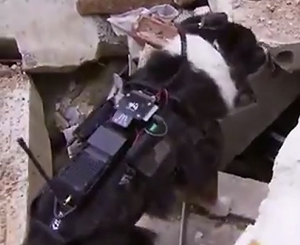 Specialist wireless communications company, Wood & Douglas is introducing a new communications kit designed to improve the video and voice control link between operators and military, and search trained working dogs.
Specialist wireless communications company, Wood & Douglas is introducing a new communications kit designed to improve the video and voice control link between operators and military, and search trained working dogs.
P.A.W.S. Wi-Fi has been developed to provide security forces with a low cost entry system for training purposes and field deployment where search dogs are expected to be in close contact with the handler, such as urban search, drug and explosives detection. With P.A.W.S. Wi-Fi and the handler in close proximity, dogs in training gain rapid confidence when wearing the live video system.
With a head mounted video camera, P.A.W.S. Wi-Fi enables a dog to operate without any discomfort, beaming real-time video to its handler for search & rescue, military operations support, explosives and drugs detection.

With a camera that supports low light, high resolution and Infra Red ‘day for night’ vision options, the dog mounted video system can be used to search buildings and difficult to traverse terrain; locate and then positively identify suspect packages, devices, or individuals, providing evidence gathering for prosecution or operational assessment.
Once familiarised with the system, canine teams posted on operations rapidly adapt to the full P.A.W.S. system, which offers enhanced link performance in any environment with full CofDM video and a two-way audio link. The CofDM video extends the transmission range for P.A.W.S., even deep into buildings or underground, enabling dogs to range further and still provide live intelligence from areas otherwise inaccessible to the handler. The audio link allows the handler to instruct the dog remotely and communicate with those caught on camera.
Alan Wood, Managing Director, Wood & Douglas, says, “P.A.W.S Wi-Fi introduces greater flexibility into a system that already makes hazardous jobs safer for both the dog and handler. It can help speed up training and enable dogs to quickly acclimatise to using equipment that uniquely enhances intelligence gathering and helps save lives.”
















